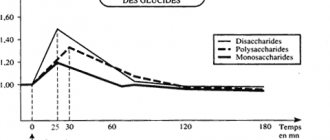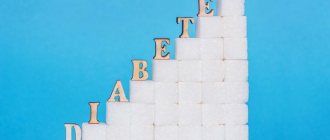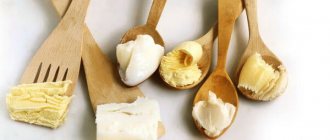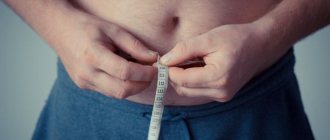What is fiber
Fiber is a fairly strong and tough substance. It is part of the cell walls of plants, with the exception of algae.
At high magnification, it looks like a bundle of long fibers connected to each other. They are elastic and durable, resistant to the action of digestive enzymes.
Fiber provides little energy and is almost not digestible. But dietary fiber is necessary for the functioning of the body and the prevention of diseases.
Types of dietary fiber:
- Cellulose.
- Hemicellulose.
- Pectins.
- Lignin.
- Slime.
- Comedy.
The walls of plant cells are made of cellulose. Hemicellulose, pectins and lignin are intercellular carbohydrates. Mucus is isolated from seaweed and the seeds of some plants. Gums - from the stems and seeds of tropical flora.
Dietary fiber absorbs moisture well, swells, and doubles its volume. The grain shells (bran) absorb water five times their weight.
Flour products contain almost no fiber. It is completely absent from animal products.
Daily norms
Researchers say the average woman consumes about 13 grams of fiber daily, and men about 17 grams. Meanwhile, nutritionists have found that fiber is so important for humans that it should be present in the diet every day. At the same time, men under 50 years old should consume approximately 38 grams of fiber per day, older ones - about 30 grams. Women under 50 years of age are recommended to consume about 25 g of the substance daily, and 21 g per day is enough for women over 50. It is not difficult to provide yourself with these portions if your daily diet contains whole fruits and vegetables, nuts and seeds.
The required amount of fiber for children is determined taking into account age categories: children under 3 years old should receive 19 g of the substance per day, 4-8 years old - about 25 g per day, girls 9-18 years old - 26 g each, boys 9-13 years old – 31 g each, boys 14-18 years old – 38 g each.
Nutritionists say that the ratio of insoluble to soluble fiber should be 75% to 25%. But since many products (rolled oats, bran, flax seeds and others) contain two types of dietary fiber, you should not specifically calculate the proportions.
Insoluble fiber
Water-insoluble fibers - cellulose, lignin - are found in cabbage, green peas, apples, carrots, and cucumber peels.
Cellulose absorbs moisture from waste, gives it volume and moisture, and speeds up passage and evacuation.
Lignin binds bile acids and reduces cholesterol levels in the blood. Reduces the risk of gallstones. Storing vegetables increases its quantity.
Insoluble fiber increases the volume of waste after the breakdown of food, which stimulates peristalsis - wave-like contractions of the intestinal walls, irritates them for regular bowel movements, and prevents constipation.
Products containing insoluble fiber cleanse the intestinal walls. A “washcloth” made of durable fibers reliably binds and evacuates waste. Otherwise, they rot, ferment, and increase the population of pathogenic microflora in the intestines.
Pathogenic microflora produces its own waste, which penetrates the blood through the intestinal walls, destroys the mucous membrane, and causes diseases of the digestive system and tumors.
The body reacts and uses up its defenses. Supporting natural physiological processes in the intestines with insoluble fiber preserves immunity and normalizes metabolism.
Water-soluble fibers
Water-soluble fibers - pectins, resins (legumes), alginase (algae), hemicellulose (oats, barley) - when absorbing water, do not swell like cellulose, but form a voluminous jelly with astringent properties.
Pectin substances give firmness and elasticity to plant tissues and help resist drought. Pectins and resins contribute to long-term storage of the product.
Water-soluble fiber contains few calories, quickly saturates, and inhibits the absorption of carbohydrates and fats. A slow increase in blood sugar levels requires less insulin, which promotes fat storage and excess weight.
Microflora breaks down pectins in the large intestine, which increases the acidic environment, which helps destroy pathogenic microorganisms.
Products rich in water-soluble fiber maintain microflora balance and reduce the content of putrefactive bacteria in the intestines.
What other types are there?
Fibers are classified not only into soluble and not.
From a scientific point of view, several approaches to the taxonomy of dietary fiber can be distinguished (with the exception of the criterion of solubility in water). The main types are:
- Lignin. This is a substance found in woody plant cells.
- Non-starch polysaccharides. This group includes cellulose and non-cellulose polysaccharides: hemicellulose (hemicellulose, pectin, gum, mucus).
Depending on the chemical structure there are:
- fibers that do not contain carbohydrates (lignin);
- polysaccharides (pectin, hemicellulose, etc.).
Depending on the nature of the source:
- traditional fibers (cereals and legumes, vegetables and root vegetables, fruits and berries, mushrooms, nuts, sea plants);
- non-traditional fibers (stems of cereals and herbs, coniferous and deciduous wood).
According to the degree of fermentation (by the microflora of the digestive tract):
- with a high degree of fermentation (pectins, hemicellulose, mucus);
- partially fermentable (cellulose);
- non-fermentable (lignin).
Let us dwell on certain types of dietary fiber that have a significant effect on the human body.
Fermentable fibers
The gastric tract of each person is home to about 100,000,000,000,000 microorganisms, most of them located in the large intestine. Fermentable fibers, according to Canadian scientists, reach the final sections of the digestive tube in virtually unchanged form and serve as “food” for beneficial representatives of the microflora.
Noble bacteria ferment it, increase the activity of their vital functions, which leads to a decrease in the number of pathogenic and opportunistic forms. Fermentable fibers include: guar gum, inulin, beta-glucans, pectins.
Beneficial bacterial agents have a complex effect on the human body. For example, they are able to synthesize individual substances (butyrate, propionate, acetate), which reduce the risk of developing diseases in the digestive and cardiovascular systems and provide cancer prevention.
Maintaining normal microflora, according to experiments on rodents, reduces the body's susceptibility to stress and depression, helps prevent irritable bowel syndrome and other infectious and inflammatory lesions of the digestive tube.
Italian experts claim that the growth of noble microorganisms, supported by constant consumption of fermentable fibers, has a beneficial effect on body weight and prevents the onset and progression of obesity.
The most important source of fermentable fiber is legumes. 200 g of plants provide half of the daily fiber requirement.
Fermentable fibers are an indispensable source of nutrition for noble microorganisms that live in the lumen of the gastrointestinal tract and have a comprehensive positive effect on the human body.
Viscous fibers
Individual representatives of soluble fibers, when mixed with water, form an extremely thick jelly-like mass, which significantly slows down the rate of gastric emptying and the subsequent movement of food particles through the digestive tract.
One American review showed that viscous fibers, due to their biological properties, promote a quick feeling of fullness, lead to a decrease in food cravings and weight loss. Additional inclusion of this type of fiber is effective in preventing and treating obesity.
An increase in the “viscosity” of feces helps reduce the reabsorption of fatty acids used for the synthesis of atherogenic cholesterol and reduces the concentration of glucose in the blood.
The most effective types are pectins, bega glucans and guar gum.
Natural sources are legumes, asparagus, oats, flax seeds, Brussels sprouts.
Viscous fibers form a jelly-like mass, which remains in the digestive tract for a long time and suppresses appetite, which has a beneficial effect on the energy value of the daily diet.
Resistant starch
Resistant starch is a long chain complex of glucose. It is the main type of carbohydrates in every person’s diet.
Resistant starch passes unchanged through all parts of the intestine and serves as a source of valuable nutrients for beneficial representatives of the microbiocenosis of the large intestine.
According to American studies, the product causes a quick feeling of fullness and helps reduce overall food consumption.
Some studies by scientists show that this type of starch helps increase the sensitivity of insulin receptors on fat and muscle cells. As a result, the product normalizes the exchange of insulin and glucose in the body, ensures the prevention of type II diabetes mellitus and other pathologies of the glycemic profile.
The leader in the content of this type of fiber is potato. Green bananas, legumes, and oats are also rich in resistant starch.
Resistant starch passes unchanged to the final sections of the digestive tract, where it is actively fermented by microorganisms. It has many advantages in relation to the human body: normalizes sugar metabolism, promotes weight loss.
Other types
The following types of fibers are also important for the adequate course of digestive processes:
- Fructans. They are chains of fructose molecules. They are a source of food for friendly microflora and are used to treat a number of dyspeptic disorders (flatulence, diarrhea). The main source is wheat.
- Beta glucans. They have many beneficial properties: they reduce the concentration of glucose in the blood plasma, normalize the lipid profile, and promote rapid saturation of the body. The main natural sources are oats and barley.
- Glucomannan. It is a biologically active food supplement. It is obtained by processing the roots of the konjac plant. According to Norwegian researchers, it causes a significant reduction in body weight. It also normalizes the course of digestive processes and reduces the risk of mortality from cardiovascular diseases.
How to take fiber
Include greens, fruits, vegetables, and grains in your diet, which are consumed in their natural form, and not as puree or juice.
Dishes after mechanical and thermal processing are useful as an alternative - when natural products rich in fiber injure weakened mucous membranes and worsen the condition in the treatment of gastrointestinal diseases.
Replace cakes and buns with bran bread or wholemeal bread.
Eat fiber foods throughout the day, not just for breakfast.
Nutritionists recommend the following dosage regimen (in fractions of the daily diet):
- vegetable salads, greens – 1/4;
- fresh fruits – 1/4;
- root vegetables after heat treatment – 1/4.
The remaining 1/4 of the daily diet:
- Carbohydrates: cereals, bread, sugar – 1/10.
- Protein: nuts, milk, fermented milk products – 1/10.
- Fats: animal and vegetable fats – 1/20.
Include fiber in your diet gradually, reaching the recommended level within a month or two. Otherwise, the stool becomes bloated and the stool is disturbed.
A diet low in fat and high in fiber is beneficial for diabetes.
Contraindications
Despite its beneficial properties, fiber, when consumed in excess (more than 40 grams per day), especially in the form of insoluble fiber, causes intestinal dysfunction, which is accompanied by symptoms such as:
- bloating;
- flatulence;
- diarrhea;
- stomach cramps;
- dehydration.
There are also diseases in which the consumption of foods high in fiber is contraindicated due to possible negative effects on the gastrointestinal mucosa:
- stomach and duodenal ulcers;
- colitis;
- erosive and adhesive bowel diseases;
- haemorrhoids;
- intestinal flu.
If you have symptoms of these diseases, you should exclude foods with insoluble fiber from your diet, and consume vegetables exclusively in baked or boiled form.
Fiber and constipation
A possible cause of constipation (constipation) is retention of stool for more than two days, difficulty in bowel movements - lack of fiber products.
Stool retention causes prolonged contact of feces with the mucous membrane of the colon, its destruction by carcinogens.
If you are prone to constipation, exclude or limit easily digestible dishes - fish and meat soups, white bread, mashed potatoes, etc.
Include foods rich in plant fiber in your diet, such as nuts. They are high in calories and contain dietary fiber. A table of which foods contain fiber is presented below in this article.
On the other hand, constipation is caused by the inclusion of dietary fiber in the menu without sufficient fluid intake - up to 2 liters per day. The recommended amount includes water, tea, coffee, milk, soup, etc. If there is a lack of moisture, fiber does not bring benefits; it takes water from the body.
An indicator of sufficient fluid intake is the color of urine. If it is light, there is enough water. A rich yellow tint indicates a deficiency and the risk of constipation.
Drinking liquid immediately after eating fruit (for example, apples) causes increased gas formation.
Recipes for constipation with foods containing fiber
Recipe 1:
- Coarsely grate 100g carrots and 100g cucumbers, add 5g flax seeds, 5g dill seeds.
Eat at night.
Recipe 2:
- Grate 200g of fresh pumpkin with peel, add 100g of grated boiled beets.
Use in three doses.
Recipe 3:
- Coarsely grate 300g of boiled beets, add 50g of shelled walnuts, 150g of prunes.
Consume 100g of the mixture three times a day. Treat constipation for two days.
List and table of foods containing fiber
Vegetables and fruits often contain both soluble and insoluble fiber. For example, the peel of apples contains insoluble fiber, and the pulp contains soluble fiber.
Sometimes the peels of vegetables and fruits contain harmful substances. For example, cucumbers cleanse the body and have a diuretic effect. But their peel accumulates nitrates. Therefore, it is better to peel a store-bought cucumber before using it.
Raw foods without heat or mechanical processing (purees) contain more fiber.
Porridges are rich in it:
- Oatmeal contains a lot of fiber, which envelops and relieves inflammation of the gastric mucosa.
- Wheat promotes the activity of the brain, heart, blood vessels, and organs of the digestive system.
- Millet improves intestinal motility, normalizes fat metabolism and blood glucose levels.
- Barley is useful for metabolic disorders, creates a feeling of fullness for a long time, and has a mild laxative effect.
It is useful to add berries, nuts, fruits, and raisins to porridge.
Below is a list of foods that contain dietary fiber:
Table of foods containing the most fiber
| Product (100g) | Fiber content (grams) |
| Beans | |
| Green peas | 6,00 |
| Beans (beans) | 3,70 |
| Lentils | 3,70 |
| Greenery | |
| Fennel | 4,30 |
| Spinach | 2,70 |
| Dill | 2,60 |
| Green onion | 2,10 |
| Lettuce with dense leaves | 2,10 |
| Parsley (greens) | 1,80 |
| Celery (leaves) | 1,40 |
| Asparagus | 1,30 |
| Green salad | 0,50 |
| Grains | |
| Wheat bran | 12,00 |
| Oats | 10,70 |
| Unpeeled rice | 9,00 |
| Puffed corn | 3,90 |
| Boiled corn | 3,10 |
| Oatmeal "Hercules" | 3,10 |
| Bran bread | 2,20 |
| Rye bread | 1,10 |
| Millet | 0,70 |
| Wheat bread | 0,20 |
| Cereals | |
| Buckwheat | 10,80 |
| Oatmeal | 2,80 |
| Millet groats | 2,70 |
| Pearl barley | 2,00 |
| Rice groats | 1,40 |
| Barley groats | 1,40 |
| Vegetables | |
| Broccoli | 3,30 |
| Brussels sprouts | 3,00 |
| Bulb onions | 3,00 |
| Carrot | 3,00 |
| Horseradish (root) | 2,80 |
| Cauliflower | 2,10 |
| Beet | 2,10 |
| White cabbage | 2,00 |
| Radish | 1,80 |
| Radish | 1,50 |
| Turnip | 1,50 |
| Eggplant | 1,30 |
| Tomatoes | 1,20 |
| Pumpkin | 1,20 |
| Potato | 1,10 |
| Sweet pepper | 1,10 |
| cucumbers | 0,70 |
| Zucchini | 0,40 |
| Nuts | |
| Peanut | 9,00 |
| Almond | 9,00 |
| Hazelnut | 6,10 |
| Hazelnut | 6,00 |
| Fruits | |
| Unpeeled apples | 4,10 |
| Dates | 3,60 |
| Dried apricot | 3,50 |
| Dried apricots | 3,20 |
| Pomegranate | 2,50 |
| Peaches | 2,50 |
| Orange | 2,40 |
| Plum | 1,40 |
| Lemon | 1,30 |
| Fresh apricot | 0,80 |
| Banana | 0,80 |
| Tangerines | 0,80 |
| Grapefruit | 0,70 |
| Pear | 0,60 |
| Melon | 0,60 |
| Watermelon | 0,50 |
| Berries | |
| Dried figs | 5,30 |
| Raspberries | 5,10 |
| Sea buckthorn | 4,70 |
| Strawberries | 4,00 |
| Rose hip | 4,00 |
| Grape | 3,30 |
| Raisin | 3,20 |
| Prunes | 3,20 |
| Black currant | 3,00 |
| Rowan chokeberry | 2,70 |
| Red currants | 2,50 |
| Gooseberry | 2,20 |
| Blueberry | 2,20 |
| Blackberry | 2,00 |
| Cranberry | 2,00 |
| Cowberry | 1,60 |
| Cherry | 1,50 |
Fiber bomb for breakfast - recipe
This healthy breakfast, containing a high proportion of fiber (soluble and insoluble), will provide a boost of energy that will be gradually released into the blood, improve digestion, and normalize stool.
Types of fruit may vary depending on taste or season. Thanks to improved health and excellent taste, such a breakfast will significantly improve your mood! You need:
- 200 g white yoghurt;
- 2 tbsp. oatmeal (whole or chopped);
- kernels of 2 whole walnuts;
- 2 almonds;
- 3 strawberries;
- 1 kiwi;
- a few cubes of dark chocolate (optional)
Advice. For a delicious breakfast, use a tall cup or glass (like for ice cream). Cook it in the evening so that the oatmeal is soaked and soft in the morning. If you use crushed oatmeal, you can cook it in the morning.
Mix white yogurt with oatmeal and refrigerate overnight. In the morning, wash the strawberries, cut them in half, peel the kiwi, cut into slices or circles. Stir fresh fruit into a mixture of yogurt and cereal. Top with nuts and sprinkle with chocolate chips if desired.
This dessert, which doubles as a healthy, full breakfast, is consumed before a physically demanding day, travel, sports, or simply if you want to make your morning (and the whole day) more enjoyable. If you think there isn't enough fruit in the dessert, add a banana.
Proper intake of bran
Bran (husks of grains) is a product that is rich in fiber, facilitates bowel movements, and normalizes metabolism. Immediately before use, they are added to kefir, milk, and soup.
Varieties:
- Wheat. The softest plant fibers.
- Rye. Easier to digest.
- Oatmeal. The roughest structure.
To improve your health and lose weight, start taking it with a wheat or rye variety.
Take bran gradually:
- Add 1 teaspoon to food three times a day.
- Within two weeks, increase the daily dose to 3 tbsp.
After two months, stop taking it and eat other foods rich in fiber.
Fiber requirement standards. Table by age
The daily fiber requirement is approximately 25-30 g, but most people have no more than 15 g of this substance in their diet.
For normal intestinal functioning, EFSA (European Food Safety Authority) recommends following the following consumption standards:
| Age | Floor | Daily requirement | |
| 1-3 years | boys and girls | up to 14 g | |
| 4-7 years | 17-19.5 g | ||
| 8-12 years | 22-25 g | ||
| 13-18 years old | boys and girls | 25-31 g | |
| 19-30 years old | 22-35 g | ||
| 30-50 years | men | 40 g | with a non-standard diet 14 g per 1,000 kcal |
| women | 25 g | ||
| over 50 years old | men | 30 g | |
| women | 21 g | ||
To prevent organ pathologies, as well as type 2 diabetes, it is necessary to include in the daily menu more dishes and foods rich in fiber - the volume of its consumption should be at least 30 g every day. Experts give a similar recommendation to people with cancer and obesity.










